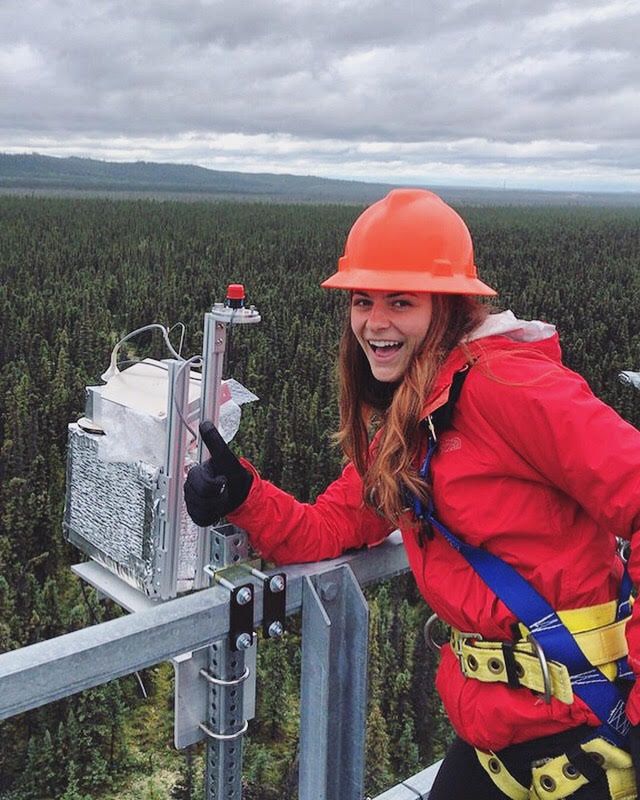Physical and Ecophysiological Drivers of Solar-Induced Chlorophyll Fluorescence
Student Spotlight: Zoe Pierrat
The world’s climate depends on the balance of carbon in the atmosphere and on Earth. Third year UCLA PhD student Zoe Pierrat is using remote sensing to understand plants and plant productivity in the boreal forest in order to discern what the future of ecosystems look like. Her research came about from a beautiful accident and collaboration between ecologists and atmospheric chemists that discovered a “glow” coming from measurements taken over land by way of satellites. Armed with a new understanding that this “glow” comes from plants as they photosynthesize, Zoe and fellow researchers can now measure the amount of light a plant emits, also known as solar-induced chlorophyll fluorescence, and more accurately connect this measurement to plant productivity and carbon uptake.
At UCLA, Zoe has been involved in the Society of Women Geoscientists, Queer and Trans in STEM, Chi Epsilion Pi, and the center for Diverse Leadership in Science. Her motivation for her involvement in these organizations comes from a desire for community in an academic setting where women are severely underrepresented, and a passion to help create a more inclusive scientific world. Prior to UCLA, she was also fortunate enough to attend the American Geophysical Union as well as participate in a NSF funded Research Experience for Undergraduates (REU) program, which solidified her decision to pursue a career in STEM. Surrounded by a sea of scientists, her enthusiasm gravitated her to advisor Dr. Jochen Stutz, an Atmospheric Chemistry Professor at UCLA’s Atmospheric and Oceanic Science Department, a man who specializes in experimental field studies and instrument development, including the one that Zoe is now using.


Under the mentorship of Dr. Stutz, Zoe and a group of researchers have installed a remote sensing system called PhotoSpec in the boreal forest to see how they can effectively take measurements of solar-induced chlorophyll fluorescence and therefore better understand the “glowing” light a satellite sees. These intermediate measurements are taken by a telescopic instrument installed on top of a tower and connected to multiple spectrometers stationed below it in order to scan and relay data taken of incredibly small amounts of light. The data received by this spectral observer is controlled by a computer attached to the sensor and sent back to Zoe and her team to review. Through these remote sensing calculations, Zoe’s team is discovering more about the complicated relationship between light and carbon, as well as the changes in climate. The light emitted from photosynthesis can depend on both physical aspects of the measurement such as viewing direction, sun/cloud conditions when the measurement was taken, what type of plant is being studied, snow or rain fall, and ecophysiological aspects such as drought, time of year (season), and the biochemistry of the plant’s needles.
The next step in Zoe’s research in the boreal forest is evaluating how direct/diffuse conditions change the signal captured by her experimental instrument. Coupled with a biochemical-radiative transfer model, these measurements will serve to inform how weather conditions affect the overall observations. Her fieldwork has led her to Canada, Alaska, and Florida in order to work alongside an extremely interdisciplinary group of collaborators. On top of the stunningly beautiful beautiful places she has been lucky enough to travel to, Zoe is even more appreciative of the incredible people she has gotten to know and learn from that specialize in far more fields than just ecology and remote-sensing. The technology Zoe is using to disentangle these effects will inform scientists of the relationship between remote sensing and carbon uptake and how to use that relationship to improve climate models. From her most recent work Zoe claims, “Climate change has led to a longer potential growing season with warmer temperatures occurring earlier in the spring but we don’t really know what this means for plants. My project addresses how we can measure the onset of photosynthesis in spring and what are the environmental drivers that trigger the onset of photosynthesis.”

